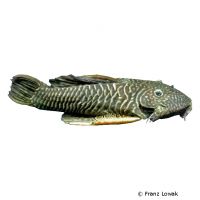Araguari-Ancistrus L56 (Pseudancistrus sp. 'L056')
| Araguari-Ancistrus L56 Pseudancistrus sp. 'L056' | |
|---|---|
| Name | Araguari-Ancistrus L56 |
| Name Lat. | Pseudancistrus sp. 'L056' |
| Synonym | Guyanancistrus L56 |
| Family | Suckermouth Armoured Catfishes |
| Family lat. | Loricariidae |
| Order | Catfishes |
| Order lat. | Siluriformes |
| Origin | Brazil |
| Habitat | Tributaries, streams |
| Diet | Limnivore, soft wood |
| pH | 5.0-7.5 |
| Behavior | Nocturnal, peaceful |
| Keeping | Individual, pair, group |
| Care Level | Moderate |
| Reproduction | Substrate spawner |
| Breeding | None reported |
| Life Span | N/A |
| Protection | No |
| Metric Units | |
| Size | 13 cm |
| Temperature | 25-29 °C |
| Hardness | 2-20 °dH |
| Aquarium | ~ 200 l |
| US Units | |
| Size | 5" |
| Temperature | 77-84 °F |
| Hardness | 36-356 ppm |
| Aquarium | ~ 50 gal |
Distribution and habitat
The distribution area of the crepuscular to nocturnal Araguari Ancistrus L56 is the catchment area of the Rio Araguari on the lower Amazon River in Amapa, Brazil. They mainly stay in shallow water with stones, roots protruding into the water and dead wood.
Maintenance
The aquarium should have a robust border planting with round stones, caves (catfish burrows) and roots, which provide hiding places and at the same time are part of the food. A substrate of sand and round gravel, subdued light (floating plant cover) and a weak current is ideal.
No ammonia, ammonium and nitrite should be detectable, the nitrate value should not exceed 100 mg/l. To ensure the water quality and oxygen content, a filter and heater adapted to the aquarium size is required, as well as lighting for the species-appropriate day-night rhythm of the animals.
Diet
They eat the vegetable cover (growth) of stones, wood, plants, etc. and the microorganisms contained therein. For a balanced diet, feed once a day with a high-quality dry food for loricariid catfish (granules, pellets, chips, tablets), supplemented with algae leaves, soft wood and fresh vegetables, such as zucchini, broccoli, bruised peas or scalded spinach, plus occasional small amounts of zooplankton, cyclops, daphnia, artemia, mosquito larvae, etc. (live or frozen). Feed only as much as will be eaten within a few minutes, excluding plant foods. Regular and varied feeding promotes health and increases resistance.
Behaviour and compatibility
They sometimes behave intra-species territorial, therefore several animals should be maintained only in large and richly structured tanks. Towards other fish they behave peacefully and are well suited for a community tank
Basically, only compatible fish species with similar demands on water quality and water temperature should be socialized.
Sex dimorphism
There are no known external distinguishing characteristics.
Reproduction and breeding
There are no known reports of successful breeding in the aquarium.
Important
They have a strong sucking mouth, with spoon-shaped teeth for scraping wood, and intestinal flora that allows the fish to digest the cellulose.
When fishing, use the finest mesh nets possible to prevent the hard rays of the pectoral fins or the skin teeth (odontodes) from getting caught on the bone plates, which can cause painful puncture wounds when touched.
The well-being of the fish should be checked regularly. Temperature should be checked daily, pH, hardness and nitrate levels at least every 14 days. Regular partial water changes are recommended, even when contaminant levels have not yet reached the upper limit. Sudden changes in water quality should be avoided. Newly introduced fish must be accustomed slowly to the water in the aquarium.
Further literature can be found in your pet store.
References
Text: Werner Winter; Image: Franz Lowak
Source: BMELV (1998): Tierschutzgutachten - Haltung von Zierfischen (Süßwasser); WERNER, LECHNER, SCHMIDT (2005): MiniAtlas L-Welse, Bede Verlag; ENGELMANN (2005): Zootierhaltung - Tiere in menschlicher Obhut: Fische, Verlag Harri Deutsch
- Gemäß § 21 Abs. 5 Tierschutzgesetz idgF
